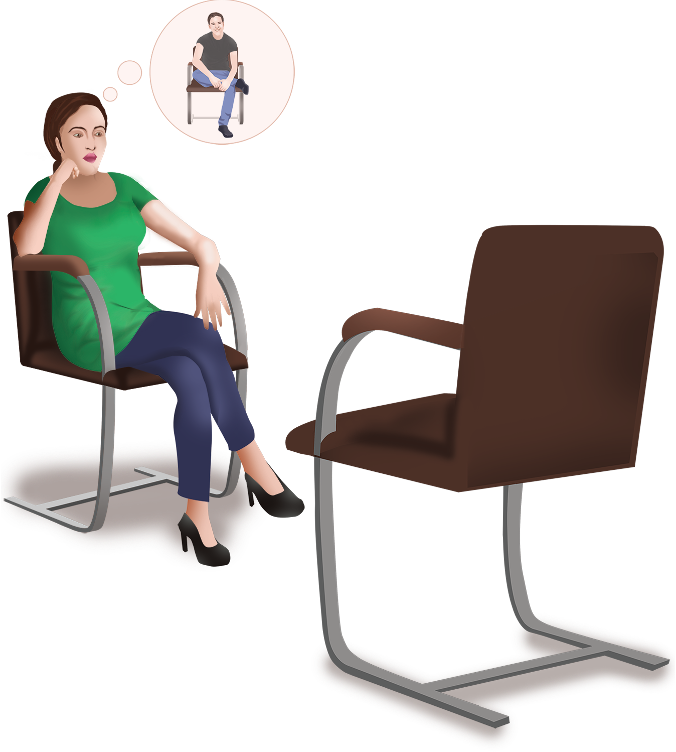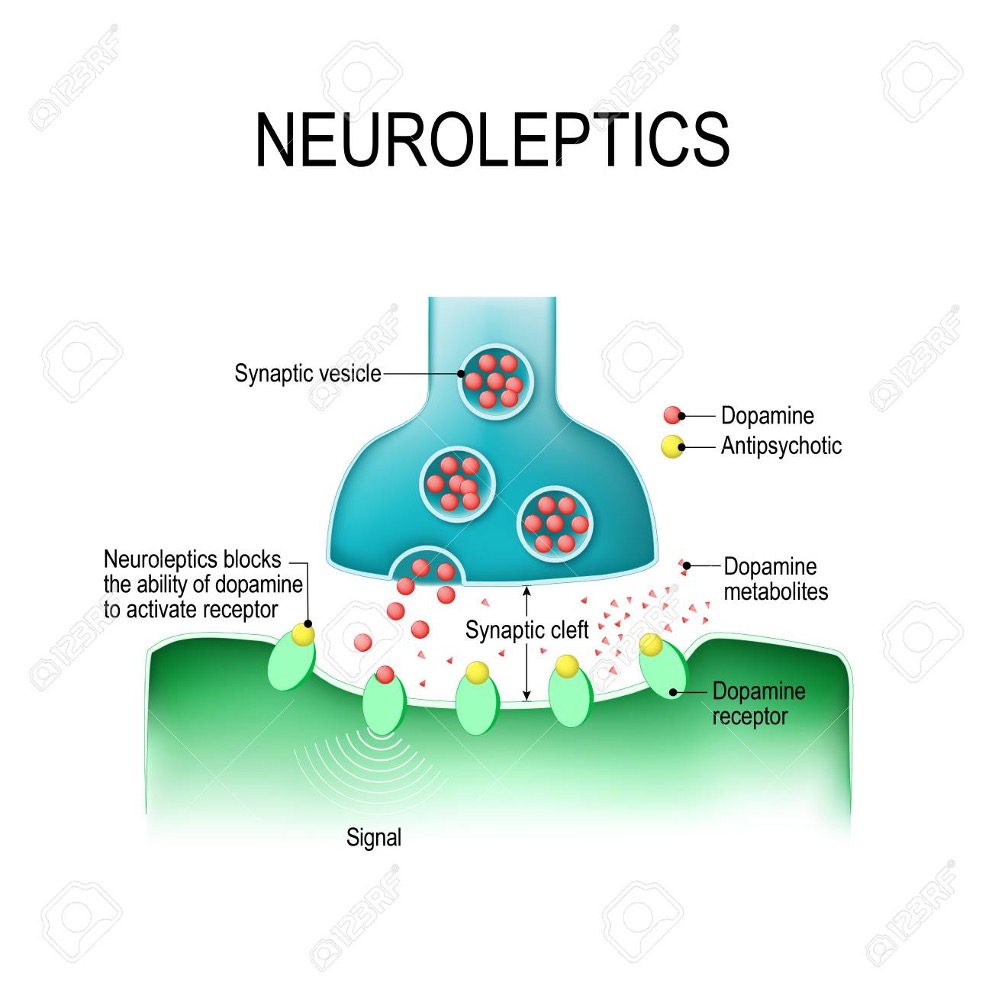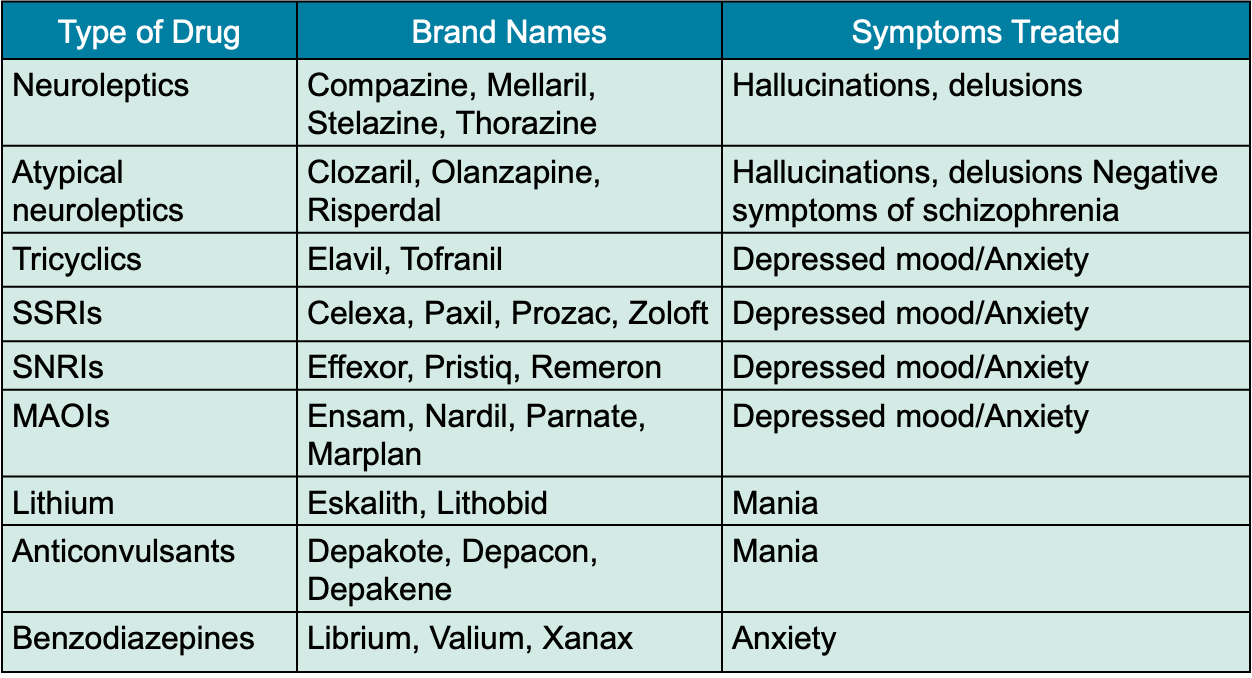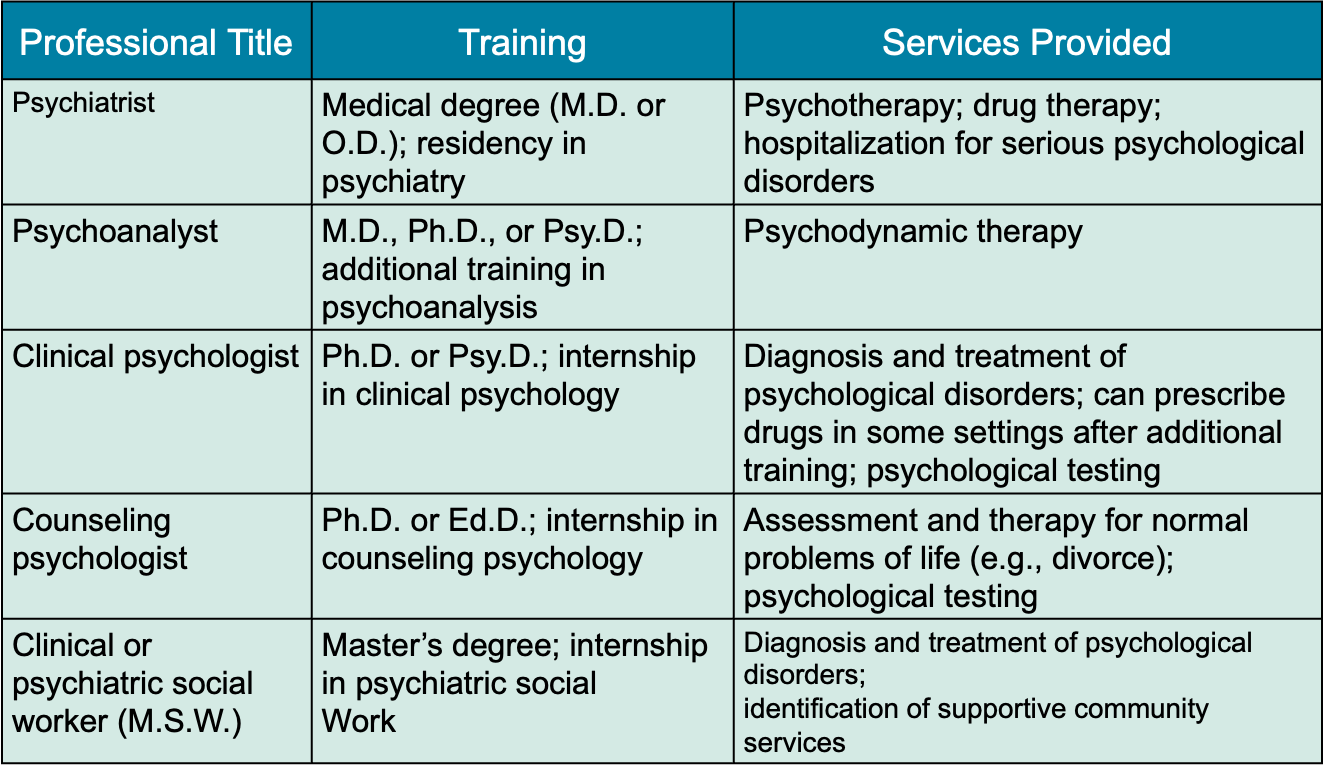
Chapter 13
 Psychotherapy: “Talk Therapy”
Psychotherapy: “Talk Therapy”
Psychotherapy
treatment that use psychological rather than biological means to treat emotional and behavioral disorders
Insight therapies
Approaches to psychotherapy based on the notion that psychological well-being depends on self-understanding and self discovery
Insight therapies: Psychodynamic therapy
Attempts to uncover repressed childhood experiences that are thought to cause the patient’s current problems
Psychodynamic = Freud = the unconscious
Insight therapies: Psychoanalysis
Psychoanalysis
first psychodynamic technique
developed by Freud
Techniques:
Free association
patient reveals first thoughts, feelings, or images come to mine
Explores the unconscious
Psychoanalytic Techniques
Psychoanalysis
techniques
dream analysis
areas of emotional concern repressed in conscious life are sometimes expressed in symbolic form in dreams.
Object relations: emotional experiences of earlier relationships become blueprints for future relationships. We sometimes act out experiences from past relationships in our current relationships.
Psychoanalysis
techniques
transference
emotional reaction that occurs during psychoanalysis
Patient displays feeling and attitudes toward the analyst present in another significant relationship; i.e. parent, SO, etc…
Insight Therapies: Interpersonal Therapy
Interpersonal Therapy (ITP)
brief psychotherapy: 12-16 sessions (or less due to insurance constraints)
effective with depression, bipolar illness and stress form significant life changes
These therapies place emphasis on the present rather than on past experiences
Interpersonal Therapy
Interpersonal therapy (ITP)
four common interpersonal problems associated with depression:
Severe response to death (or loss) of a loved one
Interpersonal role disputes, understanding other’s point of view
Difficulty adjusting to role transitions; divorce, career change, etc…
Deficits in interpersonal skills
Insight therapies: Humanistic Therapy
Humanistic therapies: assume that people have the ability and freedom to live rational lives and make rational choices, to exercise free will and develop growth
Humanistic therapy
Person-Centered Therapy
Carl Rogers (1951)
Disorder results when the natural tendency toward self-actualization is blocked, re: Maslow
The therapist attempts to create an accepting climate based on unconditional positive regard; acceptance, active listening.
Non-directive
Insight therapies: Gestalt Therapy
Developed by Fritz Perls (1969)
Goal of therapy is to help clients:
Achieve a more integrated self
Become more authentic and self-accepting, assume personal responsibility
Live in the present
Address unfinished business
In your face, directive therapy
The “empty chair” technique
 Relationship Therapies
Relationship Therapies
Relationship Therapies
look not only at the individual’s internal struggles but also at his or her interpersonal relationships
Working with the couple or family as an organism or unit
Examines family structures, dynamics and alliances
Relationship Therapies: Family Therapy
Family Therapy
Parent and children enter therapy as a group
The goal is to help family members:
Heal wounds to the family
Improve communication
Create more understanding within the family
Examine family structure
Establish boundaries
Relationship Therapies: Couples therapy
Couple Therapy
The goal is to help partners in an intimate relationship
Examine communication patterns to help encourage and improve communication
Manage conflicts more effectivley
Assist in problem solving
May focus on behavioral change or partners’ emotional responses to each other
Relationship Therapies: Group Therapy
Seven to ten clients meet regularly with one or more therapists to resolve personal problems
Provides client with a sense of belonging and the opportunity to:
Express feelings
Get feedback from other group members
Give and receive emotional support
Group Therapy
Self-Help Groups
Usually led by a non-professional
Alcoholics Anonymous
one of the oldest and best-known groups
Note: not designed to discover underlying issues contributing to substance abuse, etc…
Behavior therapies
A treatment approach consistent with the learning perspective (reinforcement, consequences, etc…) on psychological disorders
Abnormal behavior is learned
the behavior itself IS the disorder
use learning principles to eliminate inappropriate or maladaptive behaviors
The goal is to change the troublesome behavior
Behavior Modification techniques Based on Operant Conditioning
Techniques seek to control the consequences of behavior
Extinction of undesirable behavior by terminating or withholding reinforcement maintaining the behavior
Assisting client in understanding how maladaptive behaviors develop
Time Out
A behavior modification technique used to eliminate undesirable behavior, especially in children and adolescents, by withdrawing all reinforcers for a period of time.
Therapies Based on Learning theories
Systematic Desensitization
Based on classical conditioning
Used to treat fears and phobias
Client is trained in deep muscle relaxation
Pairs the feared object with relaxation
Highly successful treatment for eliminating fears and phobias in a relatively short time
Re: Little Albert
Techniques
Flooding
behaviors therapy based on classical conditioning
used to treat phobias by exposing clients to the feared object or event for an extended period, until their anxiety decreases
Client must be a willing participant
Re: Avoidant behavior
Aversion therapy
aversive stimulus paired with a harmful or socially undesirable behavior
Behavior becomes associated with pain or discomfort
Controversial
May bring intentional discomfort to client
Observational learning Therapy
Participant Modeling
Based on Albert Bandura’s principles of Observational Learning
A model demonstrates appropriate responses to a feared stimulus in graduated steps
The client imitates the model with the encouragement of a therapist
Most specific phobias can be extinguished in 3 to 4 hours
Behavior therapies
Note: behavior therapies are not aimed at discovering unconscious motivation. They are strictly designed to change or eliminate unwanted behaviors
Question: How do people develop maladaptive behaviors in the first place?
Cognitive Behavior therapies (CBT)
Assume that maladaptive behavior results from irrational thoughts, beliefs, and ideas
The approach is effective for treating a wide variety of problems such as: (cognitive) anxiety disorder, psychological drug dependence, psychological drug dependence, mood disorders
Two Best-known types of CBT
Albert Ellis’s rational emotive behavior therapy (REBT)
Aaron Beck’s cognitive therapy (CT)
Cognitive Behavior therapies: Albert Ellis’s Rational Emotive Behavior therapy
ALbert Ellis
“ as clients replace irrational beliefs with rational ones, their emotional reactions become more appropriate”
Based on Ellis’s ABC Theory
A= the activation event
B = belief about that event
C = emotional consequence that follows
Directive form of therapy
 Cognitive Behavior Therapy: Aaron Beck’s Cognitive therapy
Cognitive Behavior Therapy: Aaron Beck’s Cognitive therapy
Aaron T. Beck (1976)
Some misery endured by a person with depression and anxiety can be traced to automatic thoughts
unreasonable bu unquestioned ideas that rule a person’s life
The goal of therapy is to help clients overcome the impact of cognitive errors i.e. catastrophizing
Note: awareness is key
Cognitive Behavior therapy: Cognitive therapy (CT)
Clients first become aware of their negative cognitions
Helps clients stop negative/ dysfunctional thoughts as they occur and replace them with more productive cognitions
Therapy is breif
Seven to ten sessions
effective with mild to moderate depression and panic disorder plus other psychological conditions where faulty thinking prevails

Biomedical therapies: Drug and Surgical Therapies
Also known as biomedical therapies
Most frequently used biological treatment
Breakthroughs in drug therapies have been credited with the reduction in the amount of time a patient is hospitalized
Drug therapies: Neuropleptics
Antipsychotic Drugs
Neuroleptics: inhibit activity of dopamine
Prescribed primarily of schizophrenia
Control hallucinations, delusions, disorganized speech, and behavior

Biomedical Therapies: Atypical Neuroleptics
Atypical neuroleptics: (clozapine, risperidone) treat both positive and negative symptoms of schizophrenia
Target both serotonin and dopamine receptors
Antipsychotic Drugs: Side effects
Tardive dyskinesia
severe side effect of long-term drug use
twitching and jerking, squirming movements
Biomedical therapies: Antidepressants
Antidepressant Drugs
Improve mood in severe depression
Helpful in the treatment of certain anxiety disorders
Of the people who are anti depressants, 65 to 75 percent significantly improve; 40 to 50 percent essentially completely recover
Biomedical therapies: Types of Antidepressants
Anti-depressants (side effects)
First-Generation Antidepressants
tricyclics (amitrpytyline, imipramine0block reuptake of noepenephrine and serotonin into axon terminals
Second-generation Antidepressants
Selective serotonin reuptake inhibitors (SSRIs) Prozac
Block reuptake of serotonin, increasing its availability at synapses in the brain
Serotonin-noepenephrine reuktake inhibitors (SNRIs)
Bi-Polar and Anti-Anxiety Medication
Bi-polar disorder: lithium reduces depressive episodes as well as manic ones (liver toxicity and other side effects)
Anti-Anxiety Drugs
minor tranquilizers called benzodiazepines include:
Valium, librium and Xanax
Users may experience moderate to intense withdrawal symptoms, including intense anxiety
Highly addictive
Drug therapies
Disadvantages of Drug Therapy
Difficulty in establishing the proper dosages
Drugs do not cure psychological disorders!!
Maintenance dosages may be required to reduce possibility of recurrence
Compliance issues

Biomedical therapies: Electroconvulsive Therapy (ECT)
Electric current is administered to the right cerebral hemisphere (unilateral ECT)
patient is under anesthesia
usually reserved for severely depressed patients who are suicidal
Highly effective treatment for major depression
Possibly works by changing biochemical balance in the brain
ECT and transcranial Magnetic Stimulation
Rapid Transcranial Magnetic Stimulation
(rTMS)
newer, magnetic therapy; not invasive
no known side effects
Most have a success rate b/n 70-80 percent and about 50 percent have complete remission of depression

Biomedical Therapies: Psychosurgery
Lobotomy: Severs neural connections between frontal lobes and deeper centers involved in emotion
no longer performed
leaves patients in permanently deteriorated condition
Cingulotomy: electrodes are used to destroy the cingulum, a small bundle of nerves connecting cortex to emotion centers
Practical. Issues in Psychotherapy: Choosing a Therapist
Ethical Considerations
According to the ethics code of the American Psychological Association (2002), therapists must take reasonable steps to:
ensure the well-being and rights of client
Avoid causing them any kind of immediate or long-term harm
Informed consent
Therapists must inform clients of the cost and expected duration of therapy prior to beginning any intervention
Therapists are prohibited from providing therapy to former intimate partners

issues in Psychotherapy: Culture and Gender Sensitive therapy
Knowledge of clients’ cultural backgrounds guides the choice of therapeutic interventions and direction
Therapists recognize that differences in language, traditions/attitudes between therapists and clients can pose problems
Take into account the effects of gender on both the therapist’s and the client’s behavior. Therapists must examine their own gender-based prejudices.
Practical Issues in Psychotherapy: Evaluating the Therapies
Psychotherapy was better than no treatment
No one type of psychotherapy was more effective than another
A combination of drug therapy and psychotherapy achieved the most favorable results.
 Psychotherapy: “Talk Therapy”
Psychotherapy: “Talk Therapy”
Psychotherapy
treatment that use psychological rather than biological means to treat emotional and behavioral disorders
Insight therapies
Approaches to psychotherapy based on the notion that psychological well-being depends on self-understanding and self discovery
Insight therapies: Psychodynamic therapy
Attempts to uncover repressed childhood experiences that are thought to cause the patient’s current problems
Psychodynamic = Freud = the unconscious
Insight therapies: Psychoanalysis
Psychoanalysis
first psychodynamic technique
developed by Freud
Techniques:
Free association
patient reveals first thoughts, feelings, or images come to mine
Explores the unconscious
Psychoanalytic Techniques
Psychoanalysis
techniques
dream analysis
areas of emotional concern repressed in conscious life are sometimes expressed in symbolic form in dreams.
Object relations: emotional experiences of earlier relationships become blueprints for future relationships. We sometimes act out experiences from past relationships in our current relationships.
Psychoanalysis
techniques
transference
emotional reaction that occurs during psychoanalysis
Patient displays feeling and attitudes toward the analyst present in another significant relationship; i.e. parent, SO, etc…
Insight Therapies: Interpersonal Therapy
Interpersonal Therapy (ITP)
brief psychotherapy: 12-16 sessions (or less due to insurance constraints)
effective with depression, bipolar illness and stress form significant life changes
These therapies place emphasis on the present rather than on past experiences
Interpersonal Therapy
Interpersonal therapy (ITP)
four common interpersonal problems associated with depression:
Severe response to death (or loss) of a loved one
Interpersonal role disputes, understanding other’s point of view
Difficulty adjusting to role transitions; divorce, career change, etc…
Deficits in interpersonal skills
Insight therapies: Humanistic Therapy
Humanistic therapies: assume that people have the ability and freedom to live rational lives and make rational choices, to exercise free will and develop growth
Humanistic therapy
Person-Centered Therapy
Carl Rogers (1951)
Disorder results when the natural tendency toward self-actualization is blocked, re: Maslow
The therapist attempts to create an accepting climate based on unconditional positive regard; acceptance, active listening.
Non-directive
Insight therapies: Gestalt Therapy
Developed by Fritz Perls (1969)
Goal of therapy is to help clients:
Achieve a more integrated self
Become more authentic and self-accepting, assume personal responsibility
Live in the present
Address unfinished business
In your face, directive therapy
The “empty chair” technique
 Relationship Therapies
Relationship Therapies
Relationship Therapies
look not only at the individual’s internal struggles but also at his or her interpersonal relationships
Working with the couple or family as an organism or unit
Examines family structures, dynamics and alliances
Relationship Therapies: Family Therapy
Family Therapy
Parent and children enter therapy as a group
The goal is to help family members:
Heal wounds to the family
Improve communication
Create more understanding within the family
Examine family structure
Establish boundaries
Relationship Therapies: Couples therapy
Couple Therapy
The goal is to help partners in an intimate relationship
Examine communication patterns to help encourage and improve communication
Manage conflicts more effectivley
Assist in problem solving
May focus on behavioral change or partners’ emotional responses to each other
Relationship Therapies: Group Therapy
Seven to ten clients meet regularly with one or more therapists to resolve personal problems
Provides client with a sense of belonging and the opportunity to:
Express feelings
Get feedback from other group members
Give and receive emotional support
Group Therapy
Self-Help Groups
Usually led by a non-professional
Alcoholics Anonymous
one of the oldest and best-known groups
Note: not designed to discover underlying issues contributing to substance abuse, etc…
Behavior therapies
A treatment approach consistent with the learning perspective (reinforcement, consequences, etc…) on psychological disorders
Abnormal behavior is learned
the behavior itself IS the disorder
use learning principles to eliminate inappropriate or maladaptive behaviors
The goal is to change the troublesome behavior
Behavior Modification techniques Based on Operant Conditioning
Techniques seek to control the consequences of behavior
Extinction of undesirable behavior by terminating or withholding reinforcement maintaining the behavior
Assisting client in understanding how maladaptive behaviors develop
Time Out
A behavior modification technique used to eliminate undesirable behavior, especially in children and adolescents, by withdrawing all reinforcers for a period of time.
Therapies Based on Learning theories
Systematic Desensitization
Based on classical conditioning
Used to treat fears and phobias
Client is trained in deep muscle relaxation
Pairs the feared object with relaxation
Highly successful treatment for eliminating fears and phobias in a relatively short time
Re: Little Albert
Techniques
Flooding
behaviors therapy based on classical conditioning
used to treat phobias by exposing clients to the feared object or event for an extended period, until their anxiety decreases
Client must be a willing participant
Re: Avoidant behavior
Aversion therapy
aversive stimulus paired with a harmful or socially undesirable behavior
Behavior becomes associated with pain or discomfort
Controversial
May bring intentional discomfort to client
Observational learning Therapy
Participant Modeling
Based on Albert Bandura’s principles of Observational Learning
A model demonstrates appropriate responses to a feared stimulus in graduated steps
The client imitates the model with the encouragement of a therapist
Most specific phobias can be extinguished in 3 to 4 hours
Behavior therapies
Note: behavior therapies are not aimed at discovering unconscious motivation. They are strictly designed to change or eliminate unwanted behaviors
Question: How do people develop maladaptive behaviors in the first place?
Cognitive Behavior therapies (CBT)
Assume that maladaptive behavior results from irrational thoughts, beliefs, and ideas
The approach is effective for treating a wide variety of problems such as: (cognitive) anxiety disorder, psychological drug dependence, psychological drug dependence, mood disorders
Two Best-known types of CBT
Albert Ellis’s rational emotive behavior therapy (REBT)
Aaron Beck’s cognitive therapy (CT)
Cognitive Behavior therapies: Albert Ellis’s Rational Emotive Behavior therapy
ALbert Ellis
“ as clients replace irrational beliefs with rational ones, their emotional reactions become more appropriate”
Based on Ellis’s ABC Theory
A= the activation event
B = belief about that event
C = emotional consequence that follows
Directive form of therapy
 Cognitive Behavior Therapy: Aaron Beck’s Cognitive therapy
Cognitive Behavior Therapy: Aaron Beck’s Cognitive therapy
Aaron T. Beck (1976)
Some misery endured by a person with depression and anxiety can be traced to automatic thoughts
unreasonable bu unquestioned ideas that rule a person’s life
The goal of therapy is to help clients overcome the impact of cognitive errors i.e. catastrophizing
Note: awareness is key
Cognitive Behavior therapy: Cognitive therapy (CT)
Clients first become aware of their negative cognitions
Helps clients stop negative/ dysfunctional thoughts as they occur and replace them with more productive cognitions
Therapy is breif
Seven to ten sessions
effective with mild to moderate depression and panic disorder plus other psychological conditions where faulty thinking prevails

Biomedical therapies: Drug and Surgical Therapies
Also known as biomedical therapies
Most frequently used biological treatment
Breakthroughs in drug therapies have been credited with the reduction in the amount of time a patient is hospitalized
Drug therapies: Neuropleptics
Antipsychotic Drugs
Neuroleptics: inhibit activity of dopamine
Prescribed primarily of schizophrenia
Control hallucinations, delusions, disorganized speech, and behavior

Biomedical Therapies: Atypical Neuroleptics
Atypical neuroleptics: (clozapine, risperidone) treat both positive and negative symptoms of schizophrenia
Target both serotonin and dopamine receptors
Antipsychotic Drugs: Side effects
Tardive dyskinesia
severe side effect of long-term drug use
twitching and jerking, squirming movements
Biomedical therapies: Antidepressants
Antidepressant Drugs
Improve mood in severe depression
Helpful in the treatment of certain anxiety disorders
Of the people who are anti depressants, 65 to 75 percent significantly improve; 40 to 50 percent essentially completely recover
Biomedical therapies: Types of Antidepressants
Anti-depressants (side effects)
First-Generation Antidepressants
tricyclics (amitrpytyline, imipramine0block reuptake of noepenephrine and serotonin into axon terminals
Second-generation Antidepressants
Selective serotonin reuptake inhibitors (SSRIs) Prozac
Block reuptake of serotonin, increasing its availability at synapses in the brain
Serotonin-noepenephrine reuktake inhibitors (SNRIs)
Bi-Polar and Anti-Anxiety Medication
Bi-polar disorder: lithium reduces depressive episodes as well as manic ones (liver toxicity and other side effects)
Anti-Anxiety Drugs
minor tranquilizers called benzodiazepines include:
Valium, librium and Xanax
Users may experience moderate to intense withdrawal symptoms, including intense anxiety
Highly addictive
Drug therapies
Disadvantages of Drug Therapy
Difficulty in establishing the proper dosages
Drugs do not cure psychological disorders!!
Maintenance dosages may be required to reduce possibility of recurrence
Compliance issues

Biomedical therapies: Electroconvulsive Therapy (ECT)
Electric current is administered to the right cerebral hemisphere (unilateral ECT)
patient is under anesthesia
usually reserved for severely depressed patients who are suicidal
Highly effective treatment for major depression
Possibly works by changing biochemical balance in the brain
ECT and transcranial Magnetic Stimulation
Rapid Transcranial Magnetic Stimulation
(rTMS)
newer, magnetic therapy; not invasive
no known side effects
Most have a success rate b/n 70-80 percent and about 50 percent have complete remission of depression

Biomedical Therapies: Psychosurgery
Lobotomy: Severs neural connections between frontal lobes and deeper centers involved in emotion
no longer performed
leaves patients in permanently deteriorated condition
Cingulotomy: electrodes are used to destroy the cingulum, a small bundle of nerves connecting cortex to emotion centers
Practical. Issues in Psychotherapy: Choosing a Therapist
Ethical Considerations
According to the ethics code of the American Psychological Association (2002), therapists must take reasonable steps to:
ensure the well-being and rights of client
Avoid causing them any kind of immediate or long-term harm
Informed consent
Therapists must inform clients of the cost and expected duration of therapy prior to beginning any intervention
Therapists are prohibited from providing therapy to former intimate partners

issues in Psychotherapy: Culture and Gender Sensitive therapy
Knowledge of clients’ cultural backgrounds guides the choice of therapeutic interventions and direction
Therapists recognize that differences in language, traditions/attitudes between therapists and clients can pose problems
Take into account the effects of gender on both the therapist’s and the client’s behavior. Therapists must examine their own gender-based prejudices.
Practical Issues in Psychotherapy: Evaluating the Therapies
Psychotherapy was better than no treatment
No one type of psychotherapy was more effective than another
A combination of drug therapy and psychotherapy achieved the most favorable results.